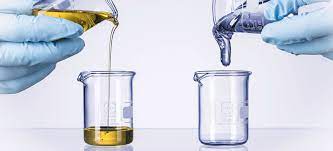Viscosity
Viscosity is a measurement of a material’s resistance to flow, typically a fluid. Viscosity can be measured using two different approaches:
- Dynamic shear viscosity: shear stress (force) is mechanically applied to the fluid, and the rate the fluid layer moves over a stationary material is measured. Viscosity = Shear Stress/Shear Rate
- Kinematic viscosity (also known as momentum diffusivity or flow time): measures the flowrate of the fluid as it moves over a stationary material under gravitational force. In this case, force is not measured, because kinematic viscosity is a measure of how fast the fluid moves under gravity.

Atomic Echo Labs performs dynamic viscosity measurements using the following types of viscometers:
- High shear rate viscometer for paints and pigmented coatings, also known as an ICI viscometer
- Krebs spindle viscometer (KU meter) for paints, pigmented coatings, pastes and adhesives
- Rotational viscometers of various torque ranges manufactured by Brookfield Engineering Corp.
For all of these instrument types, a cone, spindle or paddle is placed in contact with the test fluid and is rotated at a programmed shear rate. The instruments contain a calibrated spring that measures the fluid’s resistance to the movement. Depending on the equipment used, viscosity data can be reported in units of centipoise, poise, Pascal-seconds or Krebs units. Common ASTM test methods for dynamic viscosity include ASTM D4287, ASTM D562 and ASTM D2196. Atomic Echo Labs performs kinematic viscosity measurements using the following viscometers:
- Ubbelohde viscometer
- Cannon-Fenske viscometer
- Ford cup
- Zahn cup
- DIN cup
The cup-type viscometers are typically used for paints, inks, varnishes and highly viscous coatings.
The Ubbelohde and Cannon-Fenske viscometers utilize a glass capillary through which the fluid flows under gravity. The capillary geometry is too small for highly viscous samples. Therefore, the typical applications for capillary viscometers include: dilute polymer solutions, certain types of solvents, dilute solutions, syrups and oils. Intrinsic viscosity is an important technique for characterizing polymers in dilute solution, because it provides information related to molecular weight and the conformational shape of a specific polymer in a chosen solvent. Intrinsic viscosity is normally performed using the Ubbelohde viscometer.
Depending on the equipment used, kinematic viscosity can be reported in units of meters squared per second, stokes, centistokes or time in seconds. Common test methods for kinematic viscosity include ASTM D4212, ASTM D1200 and ASTM D445. With all viscosity techniques, temperature can greatly impact the results of testing. The more elevated the temperature, the more readily the material flows, which results in a lower measured viscosity compared to ambient or sub-ambient conditions. At Atomic Echo Labs, many of our viscometers offer select or programmed temperature control, which affords viscosity testing at constant specified temperatures.
Ideal Uses of Viscosity
- Oils, aqueous materials and solvents
- Personal care products such as soaps and lotions
- Formulations – impact of changes to formulas, aging studies, product specifications
- Paints and coatings
- Fluid foods (e.g. syrup)
- Raw material verification
- Soluble polymers
- Comparing with or generating a specification sheet
- Stability evaluation
Strengths
- Brookfield-type dynamic viscometers can determine if a fluid sample can be classified as Newtonian, non-Newtonian, thixotropic or rheopectic
- Intrinsic viscosity of polymers in dilute solution provides information related to molecular weight and the conformational shape of a specific polymer in a chosen solvent
- Product comparisons (e.g. paints, adhesives or inks)
- Studying changes in viscosity as a function of temperature, time and shear rate
- Predicting flow behavior of materials in processing and end-use conditions
Limitations
- Brookfield viscometers have a maximum speed of 200 rpm
- Volume requirements for the fluid samples differ widely among the different types of viscometers. However, many of the viscometers that require larger volumes are configured so that most of the sample is recoverable after testing. The information below gives general guidelines for required volumes and recoverability:
- Brookfield Cone and Plate: 0.5 mL per run, not recoverable
- ICI viscometer: ~1 mL, not recoverable
- Brookfield Straight Spindle viscometer: ~200-250 mL, but mostly recoverable
- Brookfield Small Sample Adapter: ~20 mL per run, but mostly recoverable
- Brookfield KU (Krebs spindle): ~1 pint, but mostly recoverable
- Ford cup, Zhan cup: variable, but mostly recoverable
Viscosity Technical Specifications
- Viscosity testing at constant specified temperature: many of our viscometers offer select or programmed temperature control
- Typical accuracy for the calibrated Brookfield viscometers is within ±1.0% of the measurement range, which can change to ±2% when using a small sample adapter
- We offer in-lab preparation of dilute polymer solutions for use with our capillary viscometers to measure intrinsic or relative viscosity
